LINES WORKSHEET
Subscribe to our ▶️ YouTube channel 🔴 for the latest videos, updates, and tips.
Question 1 :
In the xy-plane, the following two lines are parallel.
y = mx - 5
2x + 3y = 6
Find the value of m.
Question 2 :
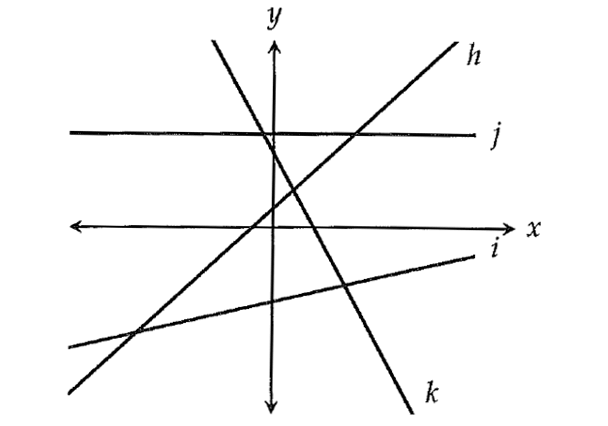
In the figure above, lines h, i, j and k are graphed in the xy-plane. Which of the following correctly orders than by their slope from least to greatest?
A) k < j < i < h
B) k < i < j < h
C) k < j < h < i
D) j < k < i < h
Question 3 :
In the xy-plane above, the line y = mx + b, where m is the slope and b is the y-intercept, is a reflection of a line across the y-axis. At which of the following points do the two lines intersect?
A) (0, b)
B) (0, -b)
C) (0, m)
D) (m , 0)
Question 4 :
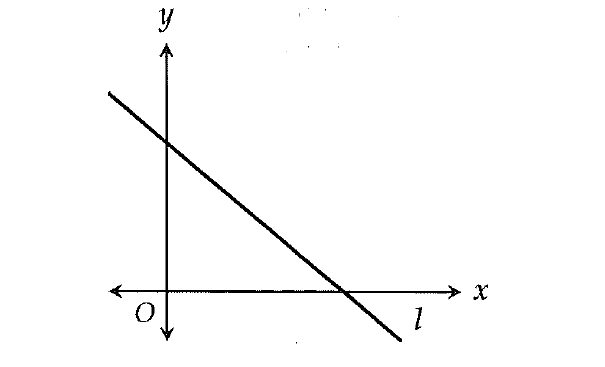
The graph of line k is shown in the xy-plane above. The equation of line n (not shown) is y = mx + b, where m and b are constants. If line k is perpendicular to line n, which of the following must be true?
A) m < 0
B) m > 0
C) b < 0
D) b > 0
Question 5 :
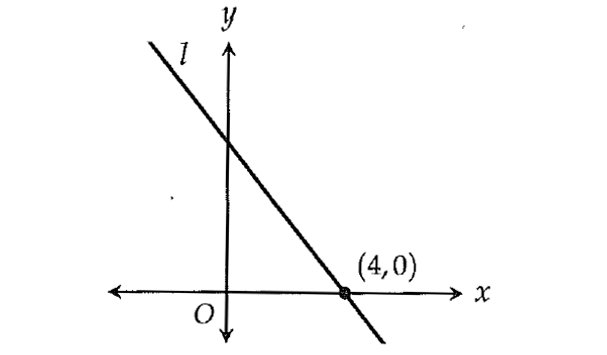
In the xy-plane above, the line l has slope -5/4. What is the area of the triangle bounded by line l, the x-axis and the y-axis?
Question 6 :
In the xy-plane above, the line with equation 3x + 4y = 6 is perpendicular to the line with equation y = mx + b, where m and b are constants. What is the value of m?
Question 7 :
If a line contains the points (0, 0) and (12, 16), then the line will also contain which of the following points?
A) (2, 3)
B) (3, 2)
C) (3, 4)
D) (4, 3)
Question 8 :
If m and b are real numbers and m > 0 and b > 0, then the line whose equation is y = mx + b can not contain which of the following points?
A) (0, 1)
B) (1, 1)
C) (-1, 1)
D) (0, -1)
Question 9 :
If a line has positive slope and positive y-intercept, then which of the following points the line can not contain?
A) (-1, 4)
B) (2, 3)
C) (1, -5)
D) (1, -4)
Question 10 :
A line with the equation y = 2x - b passes through the point (2b, -9), what is the value of b?

1. Answer :
The equation of the first line y = mx - 5 is in slope- intercept form and its slope is 'm'
Write the equation of the second line 2x + 3y = 6 in slope-intercept for, that is y = mx + b.
2x + 3y = 6
Subtract 2x from both sides.
3y = -2x + 6
Divide both sides by 3.
3y/3 = -2x/3 + 6/3
y = -2x/3 + 2
Comparing y = -2x/3 + 2 with y = mx + b, m = -2/3.
Since the lines are parallel, slopes are equal.
slope of the 1st line = slope of the 2nd line
m = -2/3
2. Answer :

In the figure above, k is a falling line.
slope of k is negative ----(1)
The lines h, i and j are raising lines, hence their slopes are positive.
Line h is steeper than the line i.
slope of i < slope of h ----(2)
Line i is steeper than the line j.
slope of j < slope of i ----(2)
Comparing (1), (2) and (30,
slope of k < slope of j < slope of i < slope of h
The correct answer choice is (A).
3. Answer :
A line and its reflection across the y-axis intersect at the y-intercept. For the given line y = mx + b, the y-intercept is b or (0, b).
Therefore, (0, b) is the point at which the two lines intersect.
The correct answer choice is (A).
4. Answer :

The line n (not shown) may have positive y-intercept or negative y-intercept.
Given : Equation of the line n (not shown) is y = mx + b.
So, the value of the y-intercept of 'b' in y = mx + b may be positive or negative and we can not predict exactly as
b > 0 or b < 0
Hence, we can reject options (C) and (D).
If two lines are perpendicular, the product of their slopes is equal to -1. Since the product of the slopes is a negative value, one line has a positive slope and the other line has a negative slope.
The line k shown in the xy-plane above is a falling line, so it has a negative slope.
Then, the other line n (not shown) perpendicular to line k must have a positive slope.
Slope of the line y = mx + b is 'm' and it is positive.
That is
m > 0
The correct answer choice is (B).
5. Answer :
slope = -5/4
rise/run = -5/4
rise ---> 5 units down
run ----> 4 units to the right
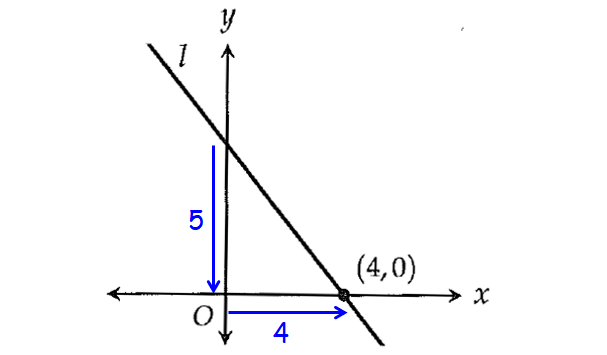
Clearly, the base of the triangle is 4 and the height is 5.
Formula for area of a triangle :
= (1/2) ⋅ b ⋅ h
Substitute b = 4 and h = 5.
= (1/2) ⋅ 4 ⋅ 5
= 20/2
= 10 square units
6. Answer :
The slope of the line y = mx + b is 'm'.
Write the equation 3x + 4y = 6 in slope-intercept form.
3x + 4y = 6
Subtract 3x from both sides.
4y = -3x + 6
Divide both sides by 4.
4y/4 = -3x/4 + 6/4
y = -3x/4 + 3/2
The equation of the line y = -3x/4 + 3/2 is in slope intercept form, that is y = mx + b.
Slope of the line y = -3x/4 + 3/2 is
m = -3/4
Given : The line with equation 3x + 4y = 6 is perpendicular to the line with equation y = mx + b.
If two lines are perpendicular to each other, the product of their slopes is equal to -1.
(-3/4) ⋅ m = -1
-3m/4 = -1
Multiply both sides by 4.
-3m = -4
Divide both sides by -3.
m = -4/3
7. Answer :
Find the slope of the line joining (0, 0) and (12, 16),
Slope of the line joining (x1, y1) and (x2, y2) ;
m = (y2 - y1)/(x2 - x1)
Substitute (x1, y1) = (0, 0) and (x2, y2) = (12, 16).
m = (16 - 0)/(12 - 0)
m = 16/12
m = 4/3
Equation of the line in slope-intercept form :
y = mx + b
Substitute m = 4/3.
y = 4x/3 + b
Since, the line is passing through the origin (0, 0), y-intercept b = 0.
Then, the equation of the line is y = 4x/3.
To find the point the line contains, check each point in the given options with the equation
y = 4x/3
A) (2, 3) :
3 = 4(2)/3
3 = 8/3 ✘
B) (3, 2) :
2 = 4(3)/3
3 = 12/3
3 = 4 ✘
C) (3, 4) :
4 = 4(3)/3
4 = 12/3
4 = 4 ✔
D) (4, 3) :
3 = 4(4)/3
3 = 16/3
3 = 16/3 ✘
The correct answer choice is (C).
8. Answer :
For the given line y = mx + b,
slope = m
y-intercept = b
It is given that m > 0 and b > 0.
Since the y-intercept b is positive, the line intersects y-axis at a positive point and it will never intersect the y-axis at a negative point.
In the given answer choices, (D) (0, -1) contains a negative point on the y-axis.
So, the line y = mx + b can not contain the point (0, -1).
The correct answer choice is (D).
9. Answer :
The slope of the line is positive, so it is a raising line.
Since the y-intercept b is positive, the line intersects y-axis at a positive point.
Graph of the line :
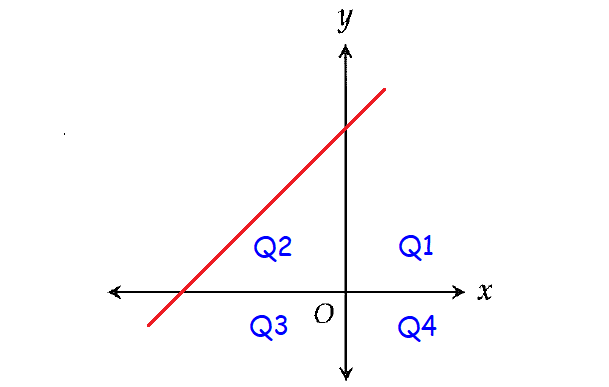
The line passes through the quadrants Q1, Q2 and Q3 and it does not pass through the quadrant 4.
In the given answer choices, (C) (1, -5) contains a point in quadrant 4.
So, the line can not contain the point (1, -5), because it is in quadrant 4.
The correct answer choice is (C).
10. Answer :
y = 2x - b
Since the line passes through the point (2b, -9), we can plug in x = 2b and y = -9 into the equation.
-9 = 2(2b) - b
-9 = 4b - b
-9 = 3b
Divide both sides by 3.
-3 = b
Subscribe to our ▶️ YouTube channel 🔴 for the latest videos, updates, and tips.
Kindly mail your feedback to v4formath@gmail.com
We always appreciate your feedback.
About Us | Contact Us | Privacy Policy
©All rights reserved. onlinemath4all.com

Recent Articles
-
10 Hard SAT Math Questions (Part - 40)
Dec 25, 25 08:30 AM
10 Hard SAT Math Questions (Part - 40) -
10 Hard SAT Math Questions (Part - 41)
Dec 24, 25 07:58 PM
10 Hard SAT Math Questions (Part - 41) -
ASTC Formula in Trigonometry
Dec 23, 25 11:34 PM
ASTC Formula in Trigonometry - Concepts - Examples and Solved Problems


